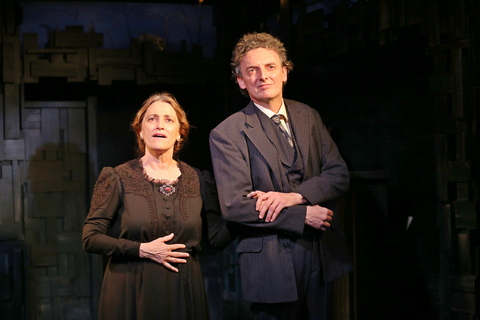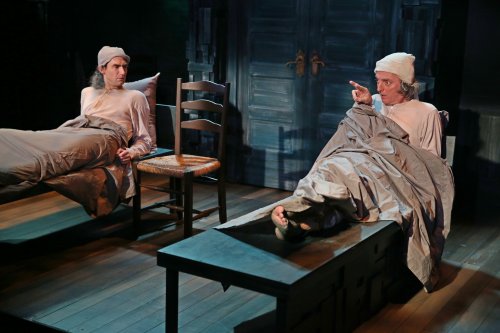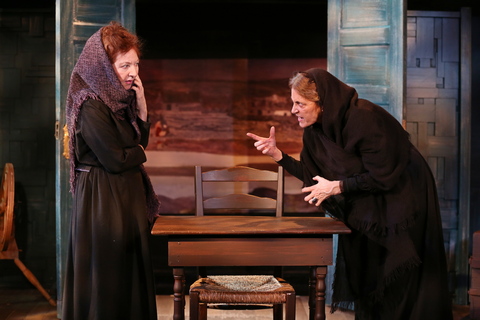Lady G: Plays and Whisperings of Lady Gregory
The Irish Repertory Theatre remembers Lady Gregory in a way that's still far too uncommon.

Úna Clancy and John Keating in a scene from “Lady G: Plays and Whisperings of Lady Gregory” at the Irish Repertory Theatre (Photo credit: Carol Rosegg)
It might be about 90 years too late, but writer/director Ciarán O’Reilly is throwing a good old-fashioned Irish wake, with poems, songs, and a slice of barmbrack (Irish sweet bread) for each of the lucky attendees. And he’s also summoned the dearly departed herself, Lady Isabella Augusta Gregory, and a few of her more notable friends (some guys named Yeats, O’Casey, and Synge) to join in the celebration, stitching together her words with some of theirs to create the waggishly titled Lady G: Plays and Whisperings of Lady Gregory. It’s a charming and touching tribute to a woman whose literary efforts are usually far less appreciated, unfortunately, than her advocacy.
Attempting to adjust the balance, O’Reilly’s patchwork paean alternates between the former and the latter, wrapping an engaging biography around two of Lady Gregory’s short dramas, “The Workhouse Ward” and “McDonough’s Wife.” It’s all done with a cheerful meta-theatrical flair as the warmly inviting Úna Clancy starts things off by announcing, “Hello. I’m Lady Isabella Augusta Gregory. Or at least that’s the role I’m playing tonight.” O’Reilly and Clancy have a lot of fun tearing down Lady Gregory’s famously patrician demeanor with self-deprecating asides, like describing Roxborough, the country estate where Lady Gregory was raised, as something out of Downton Abbey. The Irish Republican Army eventually burned her family home to the ground, information that Clancy delivers so matter-of-factly that it almost slips past you, making it the perfect encapsulation of Lady Gregory’s order of priorities.
There’s more fourth-wall breaking to come, some of it far subtler and requiring a strong familiarity with previous Irish Repertory productions, especially The O’Casey Cycle from last season in which all of the Lady G actors participated. Offering the most esoteric performative echo, the always unforgettable John Keating portrays Seán O’Casey with a knowing wink at his own sneering turn as Joxer in Juno and the Paycock; perhaps it doesn’t matter, in the grand scheme, if you’re aware there’s something allusive about the way Keating elongates the word “darlin’,” but it sure makes the smile on your face a little wider if you do.

James Russell and John Keating in a scene from Lady Gregory’s “The Workhouse Ward,” part of “Lady G: Plays and Whisperings of Lady Gregory” at the Irish Repertory Theatre (Photo credit: Carol Rosegg)
Like the rest of the cast, Keating assumes multiple roles in bringing both Lady Gregory’s personal story and her work to life. The former Isabella Augusta Persse acquired her married surname from one of the most vilified politicians in Irish history, Sir William Gregory, whose short-sighted legislative efforts during the Great Famine ultimately made the crisis worse. Lady Gregory’s much-older husband, however, also would bequeath her Coole Park, a massive and stunningly beautiful estate that served as a woodsy salon for the most monumental figures of the Irish Literary Revival and their potent mix of prodigious writing ability and budding nationalism.
Set designer Charlie Corcoran recreates a sliver of Coole Park in the Irish Rep’s studio space, even rendering a wonderful simulacrum of the famed “autograph tree,” where Lady Gregory’s most esteemed visitors would carve their initials as if signing a guest book. With an assist from David Toser’s simple, but protean, costuming, O’Reilly and his spirited actors are able to squeeze a surprising number of these beech vandals onto the stage, though no one dominates it more than William Butler Yeats, with whom Lady Gregory co-founded The Abbey Theatre.
After an appropriately rigid portrayal of Sir William Gregory, who accepted his cuckolding from the dashing anti-imperialist Wilfred Blunt with the proverbial stiff upper lip, James Russell cuts loose in his depiction of Yeats, finding every bit of passion and sadness in the poet’s heartrending lyricism. Of course, it might seem problematic that, along with healthy snippets of plays from that “odd fellow” J.M. Synge, O’Reilly dedicates a lot of time to words that don’t belong to his putative subject; it could come across as if he’s forgotten who he’s honoring.

Terry Donnelly and Úna Clancy in a scene from Lady Gregory’s “McDonough’s Wife” part of “Lady G: Plays and Whisperings of Lady Gregory” at the Irish Repertory Theatre (Photo credit: Carol Rosegg)
But there’s a sort of praise and protest in juxtaposing Lady Gregory’s talents against those of her more renowned compatriots. Although she’s appreciated for nurturing the artistic voices of others, hers mostly has been ignored, especially in Ireland, an unfairness that O’Reilly strikingly demonstrates in the staging of Lady Gregory’s pair of underseen gems. Both of them derive from her interest in the oral history of the Irish underclass, which was sparked at a young age by her Gaelic-speaking, Catholic nanny Mary Sheridan (the invaluable Terry Donnelly) whose tuneful admiration for rebellion, whether Fenian or French, made its own lasting mark, too.
Despite a dreary setting, “The Workhouse Ward” is an uproarious tête-à-tête between two bedridden codgers whose hatred for each other, built up over a lifetime, appears to be the only thing sustaining them, while “McDonough’s Wife” is something completely different, an elegiac exploration of loss and devotion. It’s also, in Lady Gregory’s own words, “a hymn of praise to the pride of the artist.” Overall, that’s how one should regard Lady G as well.
Lady G: Plays and Whisperings of Lady Gregory (extended through March 12, 2020)
The Irish Repertory Theatre
W. Scott McLucas Studio Theatre at The Irish Repertory Theatre, 132 West 22nd Street, in Manhattan
For tickets, call 212-727-2737 or visit http://www.irishrep.org
Running time: two hours and 25 minutes including one intermission






Leave a comment